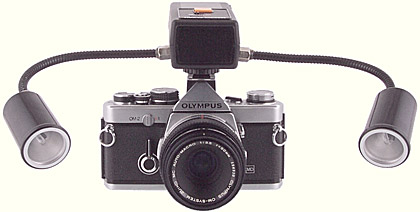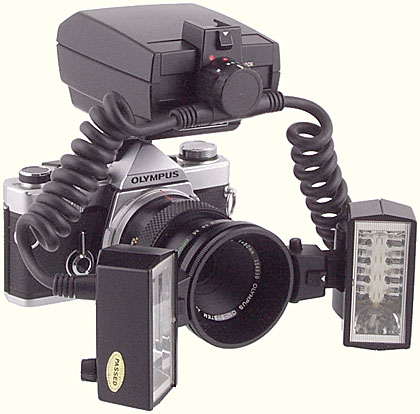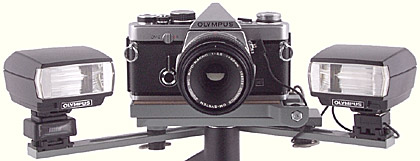Close-up and macro photography for entomologists
Lighting – Macro flash
Most conventional electronic flashguns that either fit in the camera’s accessory shoe or attach to a bracket at one side of the camera cannot be tilted downwards sufficiently to illuminate a subject that is close to the lens. Even if they are tilted down, it is quite likely that the macro lens or bellows unit will block some or all of the light from reaching the subject. To get round this problem, several camera manufacturers and independents have developed specialised flash systems for close-up and macro work.
Shoe-fitting units
Macro flash units that fit the camera’s accessory shoe have two light-weight flash heads on flexible arms that can be adjusted independently to vary the angle, distance and direction of the light falling on the subject.

Hama Macro Flash, with Zuiko Auto-Macro 50mm f/3.5 lens and Olympus OM-2 body
The Hama (or Kepcor) Macro Flash has no control over flash intensity or duration, but comes with a table of approximate exposures at various distances. For best results, it needs to be calibrated or used with a flash meter (and allowance made for light loss caused by magnification). It is light enough to be hand-held with a macro lens. The flexible arms mean that it is not easy to reproduce the exact positions of the heads.
Lens-fitting units
Filter mounts on the front of lenses were designed take filters, not the weight and leverage of one or two flashguns, so lens-fitting macro flash units are normally light in weight, containing just the flash tubes and reflectors, and use flexible cables to connect to a power supply unit in the camera’s accessory shoe.

Olympus T28 Macro Twin Flash, with Macro Flash Shoe Ring, T Power Control, Zuiko Auto-Macro 50mm f/3.5 lens and Olympus OM-2 body
The angle of the lighting can be adjusted by rotating the heads around a ring attached to the filter mount, but the direction and distance are fixed for a given working distance. Diffusers or neutral-density filters can reduce the intensity of the light from one head and make it act as a fill-in.
Lens-fitting units are mostly made by camera manufacturers and use TTL flash control to achieve correct exposure. As with any lighting, you may need to adjust the automatic exposure to allow for dark or light backgrounds. Some units have a variable-power manual mode, and you can test and calibrate them for known combinations of film speed, aperture and magnification, without worrying about backgrounds.
It is easy to reproduce the exact positions of the heads. They are light enough to be hand-held with a macro lens.
Novoflex makes an adapter that screws into the filter mount of a lens and allows one or two flashguns to be mounted at varying distances from the lens.
Bracket-fitting units
Some independents, such as Manfrotto, Kirk, Leppo and Wimberley, make special flash brackets that attach to the camera’s tripod bush and allow one or two normal TTL auto flash guns to be used for close-up and macro work. Some people make their own brackets. Single or double arms allow the distance and direction of the light to be adjusted, but there is less scope for changing the angle. The flashguns can be of different power (with the weaker acting as a fill-in), or they can be of the same power, with diffusers or neutral-density filters to allow one flashgun to act as a fill-in, reducing shadow density and avoiding excessive contrast.

Manfrotto Macro Flash Bracket, with 2 Olympus T28 flash guns, Zuiko Auto-Macro 50mm f/3.5 lens and Olympus OM-2 body
The combination of metal arms and normal flashguns can produce a fairly heavy assembly. Swivelling and sliding arms provide versatile lighting, but you need to keep careful notes of lengths and angles if you want to be able to reproduce your settings.
This type of setup was in use long before TTL auto flash control, and manual flashguns with variable output (or with paper diffusers of varying thickness) can be used to produce a calibrated system that produces accurate and repeatable results.
Others
Novoflex panel.
Send comments or questions to Alan Wood
![]()
![]()
Created 27th December 1997 — Updated 29th July 2005
Copyright © 1987–2005 Alan Wood